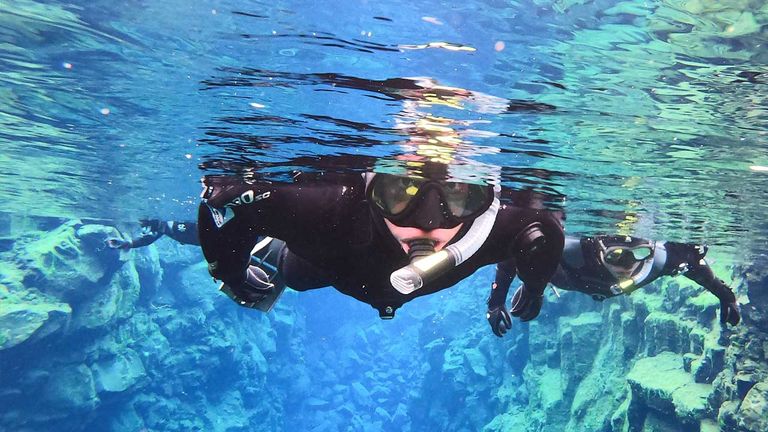Dressed in cumbersome dry suits and snorkel gear, our family of four waited for what felt like an eternity. We were standing on a set of metal platforms that descended into the end point of our Arctic Adventures’ tour: Iceland’s Silfra Fissure, a tectonic boundary filled with glacial water that’s located on Thingvallavatn Lake in Thingvellir National Park (about an hour’s drive from Reykjavik).
Our anticipation grew over the 30 minutes it took for us to step from the top platform to the final one, where we watched several other groups of snorkelers don their flippers before wading into what appeared to the untrained eye as little more than a stream tucked between volcanic rock.
“Welcome to my office,” said our Norwegian guide, Gunn (pronounced “goon”), as we reached the last platform.
She beckoned me, my husband and our two teen sons into this body of water that is anything but average.
This fissure is the only spot in the world where travelers can dive or snorkel between two continents: the North American and Eurasian plates, which continually pull apart from each other approximately 3 centimeters each year. But it also contains some of the clearest water we had ever encountered — perhaps the clearest, with visibility up to nearly 330 feet — which is melted from the nearby Langjokull Glacier and filtered through lava for 30 to 100 years before being deposited here.
It’s also a shiver-inducing 35 to 39 degrees Fahrenheit year-round. Hence the dry suit. And the nerves.
What It's Like to Snorkel the Silfra Fissure
As we glided into the icy water, I could feel my dry suit expanding with air, hugging my legs and arms to keep my body warm. The only cold sensations I felt as I began swimming were on the exposed parts of my face, especially my lips. And though my hands were protected by neoprene gloves resembling lobster claws, they allow cold water to seep through, so I placed them behind my back as Gunn had instructed, which helps keep them out of the water as guests float.
 The author and her family taking the "iconic Silfra Fissure photo”
The author and her family taking the "iconic Silfra Fissure photo”
Credit: 2022 Heather MundtThe word “silfra” in Icelandic translates to “silver” or “silvery,” a reference to the glacial water. But beneath the surface, I found a mural of bright blues and greens, the deep cobalt of the clear water contrasting against the neon green of the marine algae clinging to rocks. Often called “troll hair,” the algae looked to me like irradiated spaghetti noodles, waving to me as I passed. My boys swam ahead of me, their black dry suits interrupting the water’s two-tone kaleidoscope.
The soft current carried us gently through the first part of the tour — a narrow passageway called Silfra Crack — until we reached the spot where Gunn would snap the iconic Silfra Fissure photo: each of us posing with our right hand on Eurasia and our left on North America. We continued into Silfra Hall, which features a massive cave system with a maximum depth of nearly 150 feet, then through Silfra Cathedral, a divinely beautiful blue channel plunging more than 60 feet deep.
Often called “troll hair,” the algae looked to me like irradiated spaghetti noodles, waving to me as I passed. My boys swam ahead of me, their black dry suits interrupting the water’s two-tone kaleidoscope.
Finally, we entered the lagoon, and Gunn pointed to our left, indicating the spot where she had told us we could see its opposite side through the clear water. But it was shallow there — the rocks seemed inches from my body — and the current was suddenly strong. I craned my neck to look left, but I was distracted by the current, straining too hard to note the lagoon’s boundary before continuing.
I peeked my head above the water as I fought to swim, relieved to finally reach the exit platform. In all, we had swum less than a quarter-mile and no more than 45 minutes. But I was out of breath as I climbed the stairs, pulling off my lobster claws and flexing my hands in and out of fists to restore circulation to my bloodless fingers.
We were all invigorated and exhausted as we headed back to the support vans for cookies and hot drinks, lumbering along the path and stopping for one last photo op at a crosswalk: a snorkelers’ version of The Beatles’ “Abbey Road” album cover. Happy to have completed our adventure, I had only one thought: “Hot chocolate has never sounded so good.”
Know Before You Go: Silfra Fissure
It seems incomprehensible to be fully dressed before snorkeling, but that’s precisely what’s recommended for the Silfra Fissure tour. The best clothing to wear is a base layer such as long underwear, plus socks (yes, socks) and an extra set of clothing in case you’re the unlucky one whose dry suit leaks. Our family was unprepared, but we were able to buy long underwear at a convenience store en route to the destination — it’s very Icelandic to stock warm clothing there.